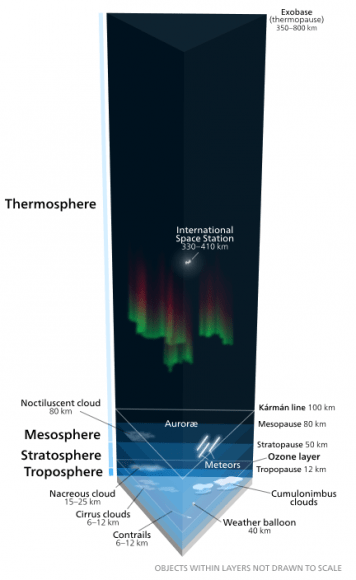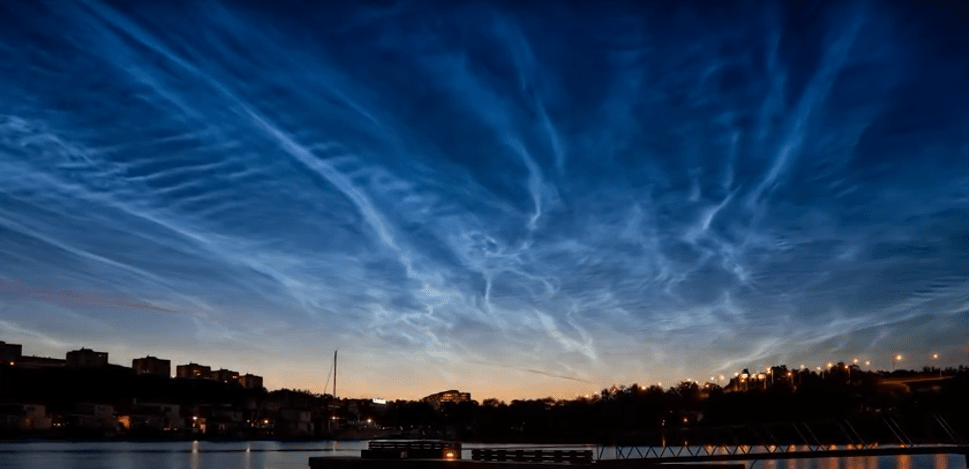Noctilucent clouds are one of the atmosphere’s most ethereal natural wonders. They form high in the mesosphere, about 80 km (50 mi) above the Earth’s surface, and are rarely seen. In July, 2018, NASA launched a five-day balloon mission, called PMC (Polar Mesospheric Clouds) Turbo, to observe them and photograph them.
Noctilucent clouds are more properly called Polar Mesospheric Clouds, because they form in the mesosphere over the Earth’s poles. They can’t be seen in daylight because they are too faint. They can only be seen when the Sun is below the observer’s horizon, and when the lower layers of the atmosphere are in the shadow of the Earth.
“From what we’ve seen so far, we expect to have a really spectacular dataset from this mission.” – Dave Fritts, Principal Investigator of the PMC Turbo mission.
Noctilucent clouds are not fully understood, which is why NASA launched the PMC Turbo mission. It launched from Estrange, Sweden, and travelled for five days across the Arctic to Western Nunavut, Canada. The mission captured 6 million high-resolution images that filled up 120 TB of data.
![Noctilucent clouds (PMC's) over Kuresoo Bog, Soomaa National Park, Estonia. Image Credit: By Martin Koitmäe [1] - Own work, CC BY-SA 4.0, https://commons.wikimedia.org/w/index.php?curid=10752455](https://www.universetoday.com/wp-content/uploads/2018/09/1200px-Helkivad_ööpilved_Kuresoo_kohal-580x386.jpg)
“From what we’ve seen so far, we expect to have a really spectacular dataset from this mission,” said Dave Fritts, principal investigator of the PMC Turbo mission at Global Atmospheric Technologies and Sciences in Boulder, Colorado. “Our cameras were likely able to capture some really interesting events and we hope will provide new insights into these complex dynamics.”
Noctilucent clouds are made of ice crystals high in the mesosphere. They form on the remnants of meteors that have burned up in the atmosphere. Studying them will help scientists understand the role of turbulence in the atmosphere and bodies of water. They should help scientists understand the atmospheres on other planets too, and could lead to better weather forecasting.
The clouds get their delicate shapes from what are known as atmospheric gravity waves. These waves are the result of uplifted air masses over mountain ranges, so studying the clouds will help us understand the role gravity waves play in the Earth’s atmosphere, and how they transfer energy through the layers of the atmosphere.

“This is the first time we’ve been able to visualize the flow of energy from larger gravity waves to smaller flow instabilities and turbulence in the upper atmosphere,” Fritts said. “At these altitudes you can literally see the gravity waves breaking — like ocean waves on the beach — and cascading to turbulence.”
“We know the 2D wave structure from the images, but in order to fully describe the waves we need to measure the third dimension as well.” – Bernd Kaifler, German Aerospace Center.
PMC Turbo’s unique mission design combines seven imaging systems which created a mosaic of wide views covering 100 miles across. Each of the seven consists of a hi-res camera, a computer control and communications system, and 32 TB of data storage capability. The cameras can also capture turbulence features as small as 18 m. (20 yards) wide.

PMC Turbo also employed a laser radar, or LIDAR, that allowed precision altitude measurements of the PMCs. The LIDAR also measure the temperature fluctuations of the gravity waves above and below the PMCs. LIDAR gave the scientists a third dimension to their data, to go along with all the imaging data.
“We know the 2D wave structure from the images, but in order to fully describe the waves we need to measure the third dimension as well,” said Bernd Kaifler, the researcher at the German Aerospace Center, in Wessling, Germany, who designed the balloon’s lidar experiment. “From the lidar measurements, we can infer the vertical structure of the waves, thus providing important data which would have not been available from the imaging experiment alone.”
The PMC Turbo mission is part of a larger NASA endeavour to understand Earth’s atmosphere and weather. NASA uses several satellites, and sub-orbital instruments like the PMC Turbo balloon mission, to examine atmospheric phenomena from different perspectives. The Aeronomy of Ice and the Mesosphere (AIM) spacecraft is also studying noctilucent clouds.
AIM and PMC Turbo are like a one-two punch when it comes to studying noctilucent clouds. AIM looks at the large-scale views of the clouds across the globe, and PMC Turbo is filling in the gaps with close-up views.
Learning about the causes and effects of PMCs and the turbulence that shapes them will help scientists understand not only the structure and variability of the upper atmosphere. It will help them turbulence in areas as well. Turbulence occurs in fluids across the universe and the results will help scientists better model it in all systems. Ultimately, the results will even help improve weather forecast models.
Sources
- NASA Press Release: NASA Balloon Mission Captures Electric Blue Clouds
- NASA Press Release: NASA’s Aim Observes Early Noctilucent Ice Clouds Over Antarctica
- NASA Press Release: Electric-Blue Clouds Appear over Antarctica
- Wikipedia Entry: Noctilucent Clouds

